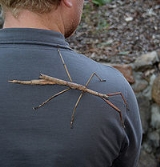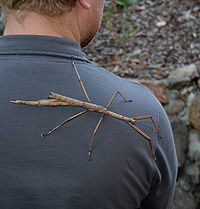
Ethnoentomology
Encyclopedia
Ethnoentomology is the study of the relationship between insect
s and people. The name is derived from "ethno
" - study of people and "entomology
" - study of insects. The focus of ethnoentomology is on how insects have been or are being used in human societies around the world. This includes insects used for food, rituals and medicine.

refers to the eating of insects. Many insects are considered a culinary delicacy
in many parts of the world, but the practice is uncommon and even taboo in other societies. Insects used in food include caterpillars
, silkworms
, Maguey worm
s, Witchetty grub
s & other beetle and moth larvae; crickets, grasshoppers
& locusts; and arachnids, such as spider
s & scorpion
s. They can be eaten on their own or mixed with other ingredients, such is the case with casu marzu
.
, which had a curative effect. Allantoin is now being used to treat the infectious bone disease, Osteomyelitis
.
Maggot Debridement therapy
is the intentional introduction of live, disinfected fly larvae into non-healing or dead skin and soft tissue wounds of a human or other animal for the purpose of selectively cleaning out only the necrotic tissue within a wound in order to promote wound healing. It is also used to prevent infection and to speed the healing process.
Apitherapy
is the medical use of honeybee products. One of the major peptide
s in bee venom, called Melittin
, is used to treat inflammation in sufferers of Rheumatoid arthritis
and Multiple sclerosis
. Melittin blocks the expression of inflammatory genes, thus reducing swelling and pain. It is administered by direct insect sting, or intramuscular injections
Cantharidin
, the blister-causing oil found in several families of beetles, was accepted by the FDA
in 2004 as treatment for warts and other skin problems. It also has historical use by the Greeks and Romans and is used as an aphrodisiac
in some societies. Another extract from Blister beetle
s has also been used to treat problems of the urogenital system.
In the Brazilian Amazon
, members of the Tupí–Guaraní language family have been observed using Pachycondyla commutata ants during female rite-of-passage ceremonies, and prescribing the sting of Pseudomyrmex spp. for fevers and headaches.
Insect
Insects are a class of living creatures within the arthropods that have a chitinous exoskeleton, a three-part body , three pairs of jointed legs, compound eyes, and two antennae...
s and people. The name is derived from "ethno
Ethnology
Ethnology is the branch of anthropology that compares and analyzes the origins, distribution, technology, religion, language, and social structure of the ethnic, racial, and/or national divisions of humanity.-Scientific discipline:Compared to ethnography, the study of single groups through direct...
" - study of people and "entomology
Entomology
Entomology is the scientific study of insects, a branch of arthropodology...
" - study of insects. The focus of ethnoentomology is on how insects have been or are being used in human societies around the world. This includes insects used for food, rituals and medicine.

Insects as food
EntomophagyEntomophagy
Entomophagy is the consumption of insects as food. Insects are eaten by many animals, but the term is generally used to refer to human consumption of insects; animals that eat insects are known as insectivores...
refers to the eating of insects. Many insects are considered a culinary delicacy
Delicacy
A delicacy is a food item that is considered highly desirable in certain cultures. Often this is because of unusual flavors or characteristics or because it is rare....
in many parts of the world, but the practice is uncommon and even taboo in other societies. Insects used in food include caterpillars
Gonimbrasia belina
Gonimbrasia belina is a species of moth found in much of Southern Africa, whose large edible caterpillar, the mopani or mopane worm, is an important source of protein for millions of indigenous Southern Africans.-Vernacular names:...
, silkworms
Beondegi
Beondegi are a popular snack food in Korean cuisine. Literally meaning "chrysalis" or "pupa" in Korean, Beondegi are steamed or boiled silkworm pupae which are seasoned and eaten as a snack. Beondegi are often served by street vendors, as well as in restaurants and drinking establishments...
, Maguey worm
Maguey worm
A maguey worm is one of two varieties of edible caterpillars that infest maguey and Agave tequilana plants. The white maguey worms, known as meocuiles, are caterpillars of a butterfly commonly named "tequila giant skipper," Aegiale hesperiaris...
s, Witchetty grub
Witchetty grub
The witchetty grub is a term used in Australia for the large, white, wood-eating larvae of several moths...
s & other beetle and moth larvae; crickets, grasshoppers
Chapulines
Chapulines, plural for chapulín, are grasshoppers of the genus Sphenarium, that are commonly eaten in certain areas of Mexico. The term is specific to Mexico and derives from the Nahuatl language...
& locusts; and arachnids, such as spider
Spider
Spiders are air-breathing arthropods that have eight legs, and chelicerae with fangs that inject venom. They are the largest order of arachnids and rank seventh in total species diversity among all other groups of organisms...
s & scorpion
Scorpion
Scorpions are predatory arthropod animals of the order Scorpiones within the class Arachnida. They have eight legs and are easily recognized by the pair of grasping claws and the narrow, segmented tail, often carried in a characteristic forward curve over the back, ending with a venomous stinger...
s. They can be eaten on their own or mixed with other ingredients, such is the case with casu marzu
Casu marzu
Casu marzu is a traditional Sardinian sheep milk cheese, notable for containing live insect larvae...
.
Insects in medicine
One of the most commonly used insects in medical purposes is the blow fly larvae. The first recorded use of it was during World War II. Military surgeons noticed that wounds which were left untreated for several days and which became infested with maggots, healed better than wounds not infested with the blow fly larvae. It was later discovered that the larvae secreted a chemical called allantoinAllantoin
Allantoin is a chemical compound with formula C4H6N4O3. It is also called 5-ureidohydantoin or glyoxyldiureide. It is a diureide of glyoxylic acid....
, which had a curative effect. Allantoin is now being used to treat the infectious bone disease, Osteomyelitis
Osteomyelitis
Osteomyelitis simply means an infection of the bone or bone marrow...
.
Maggot Debridement therapy
Maggot therapy
Maggot therapy is a type of biotherapy involving the intentional introduction of live, disinfected maggots into the non-healing skin and soft tissue wound of a human or animal for the purpose of cleaning out the...
is the intentional introduction of live, disinfected fly larvae into non-healing or dead skin and soft tissue wounds of a human or other animal for the purpose of selectively cleaning out only the necrotic tissue within a wound in order to promote wound healing. It is also used to prevent infection and to speed the healing process.
Apitherapy
Apitherapy
Apitherapy is the medical use of honey bee products. This can include the use of honey, pollen, bee bread, propolis, royal jelly, apilarnil and bee venom....
is the medical use of honeybee products. One of the major peptide
Peptide
Peptides are short polymers of amino acid monomers linked by peptide bonds. They are distinguished from proteins on the basis of size, typically containing less than 50 monomer units. The shortest peptides are dipeptides, consisting of two amino acids joined by a single peptide bond...
s in bee venom, called Melittin
Melittin
Melittin is the principal active component of apitoxin and is a powerful stimulator of phospholipase A2. Melittin is a peptide consisting of 26 amino acids with the sequence GIGAVLKVLTTGLPALISWIKRKRQQ.-Biological effects:...
, is used to treat inflammation in sufferers of Rheumatoid arthritis
Rheumatoid arthritis
Rheumatoid arthritis is a chronic, systemic inflammatory disorder that may affect many tissues and organs, but principally attacks synovial joints. The process produces an inflammatory response of the synovium secondary to hyperplasia of synovial cells, excess synovial fluid, and the development...
and Multiple sclerosis
Multiple sclerosis
Multiple sclerosis is an inflammatory disease in which the fatty myelin sheaths around the axons of the brain and spinal cord are damaged, leading to demyelination and scarring as well as a broad spectrum of signs and symptoms...
. Melittin blocks the expression of inflammatory genes, thus reducing swelling and pain. It is administered by direct insect sting, or intramuscular injections
Cantharidin
Cantharidin
Cantharidin, a type of terpenoid, is a poisonous chemical compound secreted by many species of blister beetle, and most notably by the Spanish fly, Lytta vesicatoria. The false blister beetles and cardinal beetles also have cantharidin.-History:...
, the blister-causing oil found in several families of beetles, was accepted by the FDA
Food and Drug Administration
The Food and Drug Administration is an agency of the United States Department of Health and Human Services, one of the United States federal executive departments...
in 2004 as treatment for warts and other skin problems. It also has historical use by the Greeks and Romans and is used as an aphrodisiac
Aphrodisiac
An aphrodisiac is a substance that increases sexual desire. The name comes from Aphrodite, the Greek goddess of sexuality and love. Throughout history, many foods, drinks, and behaviors have had a reputation for making sex more attainable and/or pleasurable...
in some societies. Another extract from Blister beetle
Blister beetle
Blister beetles are beetles of the family Meloidae, so called for their defensive secretion of a blistering agent, cantharidin. There are approximately 7,500 known species worldwide. Many are conspicuous and some aposematically colored, announcing their toxicity to would-be...
s has also been used to treat problems of the urogenital system.
In the Brazilian Amazon
Amazon Basin
The Amazon Basin is the part of South America drained by the Amazon River and its tributaries that drains an area of about , or roughly 40 percent of South America. The basin is located in the countries of Bolivia, Brazil, Colombia, Ecuador, Guyana, Peru, and Venezuela...
, members of the Tupí–Guaraní language family have been observed using Pachycondyla commutata ants during female rite-of-passage ceremonies, and prescribing the sting of Pseudomyrmex spp. for fevers and headaches.
See also
- EntomophobiaEntomophobiaEntomophobia is a common fear of or aversion to insects and similar arthropods, and even other terrestrial invertebrate animals, such as worms. Commonly, this condition might be referred to as the "fear of insects or bugs". This condition causes a slight to severe emotional reaction, a form of...
- EthnobiologyEthnobiology]Ethnobiology is the scientific study of dynamic relationships between peoples, biota, and environments, from the distant past to the immediate present....
- EthnozoologyEthnozoologyEthnozoology is the study of the past and present interrelationships between human cultures and the animals in their environment. It includes classification and naming of zoological forms, cultural knowedge and use of wild and domestic animals...
- Historical ecologyHistorical ecologyHistorical ecology is a research program that focuses on the interaction between humans and the environments in which they live. Rather than concentrating on one specific event, historical ecology aims to study and understand this interaction across both time and space in order to gain a full...
- William BaléeWilliam BaléeWilliam Balée is a professor of anthropology and environmental studies at Tulane University in New Orleans, Louisiana. He was born in the Miami, Florida area and educated at the University of Florida, Gainesville, where he received a B.A. in Anthropology before moving on to Columbia University in...

